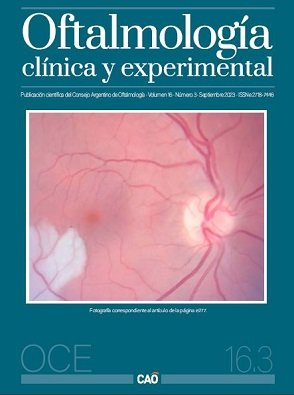Estudio clínico prospectivo de eficacia del latanoprosteno bunod 0,024%
DOI:
https://doi.org/10.70313/2718.7446.v16.n03.240Palabras clave:
latanoprosteno bunod, Vyzulta, latanoprost, superficie ocular, glaucomaResumen
Objetivo: Evaluar la eficacia hipotensora y la percepción de los pacientes tratados con latanoprosteno bunod al 0,024%.
Materiales y métodos: Se realizó un estudio clínico unicéntrico de una serie de casos con pacientes que estaban en tratamiento previo con latanoprost 0,005, quienes luego de un período de lavado comenzaron a usar latanoprosteno bunod. Se evaluó la presión intraocular antes del cambio de tratamiento y a los 3 meses, y la opinión de los pacientes explorada mediante preguntas relacionadas con las diferencias percibidas entre ambos tratamientos. También se midieron la agudeza visual mejor corregida y el aspecto biomicroscópico de la superficie ocular evaluado mediante tinción con fluoresceína (escala Oxford).
Resultados: Un total de 36 pacientes (72 ojos) realizó el estudio. La PIO fue de 13,4 ± 2,1 (9-18) al comienzo y a los 3 meses, de 13,1 ± 1,7 (9-16), diferencia que no fue estadísticamente significativa (p=0,63). El puntaje obtenido con la escala Oxford fue de 0,6 ± 0,7 (0-3) al inicio, de 0,5 ± 0,8 (0-2) al mes y disminuyó a 0,2 ± 0,8 (0-2) a los 3 meses con una diferencia estadísticamente significativa (p=0,01). Preferencia de los pacientes que antes estaban con latanoprost y que utilizaron posteriormente latanoprosteno bunod: 41,7%; latanoprost: 22,2%; indistinto: 36,1%.
Conclusión: El tratamiento con latanoprosteno bunod resultó al menos igual de eficaz que el latanoprost pero mejoró la superficie ocular. Esta podría ser una razón por la cual casi el doble de pacientes prefirieron el primer medicamento luego de tres meses de tratamiento.
Descargas
Referencias
Kaufman PL. Latanoprostene bunod ophthalmic solution 0.024% for IOP lowering in glaucoma and ocular hypertension. Expert Opin Pharmacother 2017; 18: 433-444.
Weinreb RN, Scassellati Sforzolini B, Vittitow J, Liebmann J. Latanoprostene bunod 0.024% versus timolol maleate 0.5% in subjects with open-angle glaucoma or ocular hypertension: the APOLLO Study. Ophthalmology 2016; 123: 965-973.
Medeiros FA, Martin KR, Peace J et al. Comparison of latanoprostene bunod 0.024% and timolol maleate 0.5% in open-angle glaucoma or ocular hypertension: the LUNAR Study. Am J Ophthalmol 2016; 168: 250-259.
Weinreb RN, Liebmann JM, Martin KR et al. Latanoprostene bunod 0.024% in subjects with open-angle glaucoma or ocular hypertension: pooled phase 3 study findings. J Glaucoma 2018; 27: 7-15.
Lo TC, Chen YY, Hung MC, Chou P. Latanoprostene bunod 0.024% in the treatment of open-angle glaucoma and ocular hypertension: a meta-analysis. J Clin Med 2022; 11: 4325.
Harasymowycz P, Royer C, Cui AX et al. Short-term efficacy of latanoprostene bunod for the treatment of open-angle glaucoma and ocular hypertension: a systematic literature review and a network meta-analysis. Br J Ophthalmol 2022; 106: 640-647.
Robin A, Grover DS. Compliance and adherence in glaucoma management. Indian J Ophthalmol 2011; 59 (Suppl. 1): S93-S96.
Zaharia AC, Dumitrescu OM, Radu M, Rogoz RE. Adherence to therapy in glaucoma treatment-a review. J Pers Med 2022; 12: 514.
Fogagnolo P, Torregrossa G, Tranchina L et al. Tear film osmolarity, ocular surface disease and glaucoma: a review. Curr Med Chem 2019; 26: 4241-4252.
Wallace S, Edmond J. In support of ophthalmology-specific patient-reported outcome measures. Ophthalmology 2019; 126: 690-691.
Vandenbroeck S, De Geest S, Zeyen T et al. Patient-reported outcomes (PRO’s) in glaucoma: a systematic review. Eye (Lond) 2011; 25: 555-577.
Villacorta-Gassmann P. Cuestionarios: herramientas de estudio en oftalmología. Oftalmol Clin Exp 2023; 16: e6-e14.
Bron AJ, Evans VE, Smith JA. Grading of corneal and conjunctival staining in the context of other dry eye tests. Cornea 2003; 22: 640-650.
Weinreb RN, Ong T, VOYAGER study group et al. A randomised, controlled comparison of latanoprostene bunod and latanoprost 0.005% in the treatment of ocular hypertension and open angle glaucoma: the VOYAGER study. Br J Ophthalmol 2015; 99: 738-745.
Wang Y, Liao Y, Nie X. Comparative evaluation of latanoprostene bunod, timolol maleate, and latanoprost ophthalmic solutions to assess their safety and efficacy in lowering intraocular pressure for the management of open-angle glaucoma. Clinics (São Paulo) 2020; 75: e1874.
Fenwick EK, Man RE, Aung T et al. Beyond intraocular pressure: optimizing patient-reported outcomes in glaucoma. Prog Retin Eye Res 2020; 76: 100801.
Craig JP, Nichols KK, Akpek EK et al. TFOS DEWS II definition and classification report. Ocul Surf 2017; 15: 276-283.
Arntz A, Ibañez C, Covarrubias T. Unexplained ocular and visual symptoms: the need for a psychosomatic approach in ophthalmology. Arch Soc Esp Oftalmol (Engl Ed) 2019; 94: 575-578.
Asiedu K, Dzasimatu SK, Kyei S. Impact of dry eye on psychosomatic symptoms and quality of life in a healthy youthful clinical sample. Eye Contact Lens 2018; 44 Suppl 2: S404-S409.
Sabel BA, Wang J, Cárdenas-Morales L et al. Mental stress as consequence and cause of vision loss: the dawn of psychosomatic ophthalmology for preventive and personalized medicine. EPMA J 2018; 9: 133-160.
Emmerich GM. Psychosomatic aspects in preparation and follow-up in glaucoma surgery and their special impact on patients. Klin Monbl Augenheilkd 2021; 238: 146-152.
Tau J, Passerini MS, Del Papa M et al. A novel ophthalmic latanoprost 0.005% nanoemulsion: a cytotoxicity study. Graefes Arch Clin Exp Ophthalmol 2022; 260: 1941-1946.
Casiraghi JF, Grigera D, Peyret JA et al. Efficacy and tolerability of a new latanoprost 0.005% BAK-free nanoemulsion: a nonrandomized open-label trial. Re:GEN Open 2021; 1: 110-116. Disponible en: https://www.liebertpub.com/doi/10.1089/regen.2021.0018
Tummanapalli SS, Kuppusamy R, Yeo JH et al. The role of nitric oxide in ocular surface physiology and pathophysiology. Ocul Surf 2021; 21: 37-51.
Publicado
Número
Sección
Licencia
Derechos de autor 2023 Consejo Argentino de Oftalmología

Esta obra está bajo una licencia internacional Creative Commons Atribución-NoComercial-SinDerivadas 4.0.
Con esta licencia no se permite un uso comercial de la obra original, ni la generación de obras derivadas. Las licencias Creative Commons permiten a los autores compartir y liberar sus obras en forma legal y segura.







